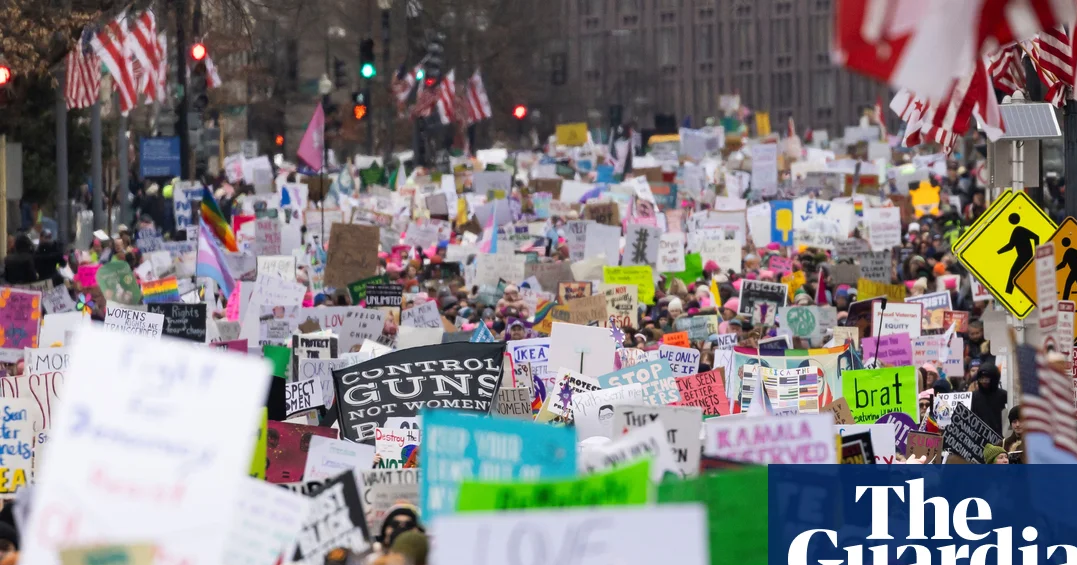Eight years since its gargantuan first protests as a reaction to the incoming president being serially accused of sexual misconduct and misogyny and campaigning on restricting reproductive rights, the Women’s March on Saturday reprised in the nation’s capital before the return of that man to the White House – with, as in 2017, spin-off rallies taking place in various other US cities.
Rebranded and reorganized, the protest was given a new name by organizers, the People’s March, as a means to broaden support, especially during a difficult and introspective time for progressive organizing after Donald Trump’s decisive win in November.
Once again, Trump beat a Democratic nominee who, if she had won, would have been the first female president of the United States. The Republican takes the oath of office on Monday to become the 47th president, having beaten Kamala Harris in 2024 more solidly even than he did Hillary Clinton in the 2016 election.
Since the last time Trump was in the Oval Office, he has been found liable in civil court for sexual abuse, as well as convicted in criminal court of a form of election fraud for paying off adult film star Stormy Daniels and disguising the transaction. And the US supreme court justices he chose tipped the balance of America’s highest court to the right and helped overturn Roe v Wade, the ruling that allowed the national right to seek an abortion and that had stood for almost 50 years.
Women outraged over Trump’s 2016 presidential win flocked to Washington DC in 2017 two days before his inauguration and organized large rallies in cities throughout the country, building the base of a grassroots movement that became known as the Women’s March. It marked one of the largest single-day demonstrations in US history.

Demonstrators at the People’s March on Saturday in Washington. Photograph: José Luis Magaña/AP

The march in downtown Washington. Photograph: Jim Lo Scalzo/EPA
At the time, Evvie Harmon, global coordinator of the marches, said initial and unofficial estimates put the crowd in Washington at more than 1 million and the attendance at events worldwide in excess of 3 million.
This year in the capital, the march was expected to be less than one-tenth the size of the 2017 march – which included huge pro-science and pro-climate-action protests – amid the realization that a majority of votes for Trump can no longer be seen as an aberration or experiment.
The comparative quiet on Saturday contrasted sharply with the white-knuckled fury of the inaugural rally, when massive crowds shouted demands over megaphones and wore vivid pink “pussy hats” by the thousands, often home-knitted, in reaction to Trump’s comments that became public in October 2016, but did not derail his campaign, that he had a habit of “grabbing” women “by the pussy” without their consent.

The march at the Lincoln Memorial on Saturday. Photograph: Justin Lane/EPA
Women’s marches were held every January for a few years, on a lesser scale, but ultimately the movement fractured amid a steady push to the right by the first Trump administration.
“The reality is that it’s just hard to capture lightning in a bottle,” said Tamika Middleton, managing director at the Women’s March. “It was a really particular moment. In 2017, we had not seen a Trump presidency and the kind of vitriol that that represented.”
A flurry of pink pussy hats still featured in the diverse crowd in a chilly downtown Washington DC on Saturday as people held signs with messages such as “Abortion rights now”, “We will not be silent” and “Stop racism” and listened to a series of speakers calling Trump’s rightwing agenda against abortion rights, transgender rights and democratic norms dangerous, while urging people to “educate, activate, advocate”, although acknowledging that many progressives “are tired”.

Demonstrators in the street in Washington on Saturday. Photograph: José Luis Magaña/AP
Saturday’s demonstrations focused on feminism, racial justice and anti-militarization, as well as other issues, and were set to end with discussions hosted by social justice organizations.
The People’s March is unusual in its “vast array of issues brought together under one umbrella”, said Jo Reger, a sociology professor who researches social movements at Oakland University in Rochester, Michigan. Women’s suffrage marches, for example, were focused on the specific goal of voting rights.
For a broad-based social justice movement such as the march, conflicting visions are impossible to avoid and there is “immense pressure” for organizers to meet everyone’s needs, Reger said. But she also said some discord isn’t necessarily a bad thing.
“Often, what it does is bring change and bring in new perspectives, especially of underrepresented voices,” Reger said.
Middleton of the Women’s March said Saturday’s goal was to draw attention broadly to women’s rights and reproductive rights, LGBTQ+ rights, immigration, climate and US democracy, rather than centering it more narrowly on Trump.
The Associated Press contributed reporting



